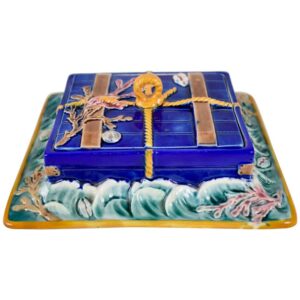About Majolica

1879
When Minton & Company of Staffordshire exhibited a new line of ceramics at The Great Exhibition of 1851 in London, the firm called it Palissy ware. The name came from a 16th-century Frenchman named Bernard Palissy, whose vividly colored, high-relief, lead-glazed plates, platters, and pitchers had inspired Minton’s new French-born art director, Léon Arnoux.
The word majolica was also used to describe the ware, since it had some commonalities with the tin-glazed 16th-century Spanish and Italian earthenware of the same name. Although the term Palissy ware was a more accurate description of Minton’s new line, the work quickly became known as majolica.
Before long there was a majolica renaissance in Europe and the United States. Majolica was made in Italy by firms such as Ginori and Cantagalli. In Germany, the Royal Porcelain Manufactory was known for its majolica. From potteries in France came the numerous designs of asparagus and artichoke plates, and serving pieces of the Alsace-Lorraine area, the 19th-century Palissy works of French ceramic artists of Paris and Tours, and the majolica of Choisy-le-Roi, Sarreguemines, Luneville, Saint Clement, and Onnaing, among others. The Massier family in Vallauris in the south of France produced the link between traditional Victorian majolica and Art Nouveau pottery. Villeroy and Boch of Germany, Wilhelm Schiller and Sons of Czechoslovakia, Mafra and Sons of Caldas de Rainha, Portugal, and Rorstrand of Sweden all contributed to the ceramic history of the latter half of the century.
These companies shared a vocabulary of images based in nature with an exuberant style. The potteries used bright colors splashed on reliefs of plants and animals. This was fun ware for the common man, and it sold as quickly as Minton and others could produce it.
Wedgwood and other Staffordshire stalwarts began producing the tin glazed earthenware as well, even though Minton had nearly a 10-year head start. Wedgwood majolica was more formal than Minton’s and used humor with restraint. While some potteries were producing teapots in the shapes of cauliflowers, Wedgwood stuck mostly to basket-weave patterns and relief foliage on the outsides of its standard shapes.
In the United States, a similar fascination with majolica took hold around the same time as the Minton debut. As in England, potteries coated their ware with clear glazes. Griffen, Smith & Hill was one prominent Pennsylvania manufacturer, who sometimes marked its pieces with “G.S.H.” or labeled them as “Etruscan Pottery.” Other American companies known for their majolica in the second half of the 19th century were Morrison & Carr, Chesapeake Pottery, and Edwin Bennett. They produced relish dishes, ice cream platters shaped like straw hats decorated with ribbons, and teapots in the shapes of cabbages.
One of the most popular majolica forms was the pitcher, which was designed in forms of bamboo, foliage, ears of corn, and seated animals. There were platters and plates, with Begonia leaf-shaped plates being a collectible subcategory all its own. Sardine boxes, like the Wedgwood example pictured at the top of this page, tea sets and humidors for storing tobacco were also popular.
In 19th-century America, young girls did much of the painting, usually earning as little as 25 cents for a 12-hour day. Before child-labor laws were enacted, children were expected to work long hours and handle lead glazes. Not surprisingly, the difficult conditions produced work that was often sloppy, as evidenced in majolica showing colors radically out of register or dripping down the side of a piece.
At the close of the reign of Queen Victoria in 1901, majolica production was reaching an end. Production had steadily increased since 1875, but with fewer original and less artistic examples. Along with the fatal effects of plumbism, lead poisoning from working with the glazes, labor and management could not resolve workers’ demands. Factory doors closed. By the 1890s, the majolica craze was ending in the United States as well. The technique felt overly baroque and garish compared to the ascendant Arts and Crafts and Art Nouveau styles. While majolica persisted in Europe, pieces from the 20th century are generally less dramatic than those from the century before, which makes them less interesting to collectors.

The Saint George Fountain, created by Minton for the International Exhibition, London, 1862.

